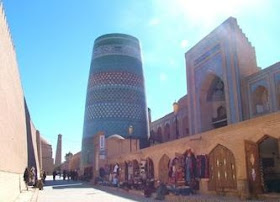 "Entrance to the Khiva Ark "
"Entrance to the Khiva Ark "The city exudes a different atmosphere to either Bukhara or Samarkand, being closer to the Persian sphere of influence. It lies some 1200 km from Tashkent and is in the heartland of ancient Khorezm once a satrap (province) of ancient Persia that once encompassed today’s northern Turkmenistan, and all of NW Uzbekistan including much of the autonomous region of Karakalpakstan.
The city, in existence by the 6th cent BC, was the capital of the Khwarazm (Khorezm) Kingdom and has been an integral part of the growth of Civilisation in Central Asia. The 712 AD Arab occupation and the introduction of Islam (over Persian Zoroastrian religious influences) changed its nature.
"Khiva - City of Minarets"
Being also at the helm of a fickle, changing Oxus River, Khiva became a critical stop on the physically hostile environment that the northern branch of the Silk Road stretched through on its way to the Caspian Sea and onto Russia.
This oasis town’s golden days were between 995AD and 1040AD when under Seljuk rule, Khiva’s master craftsmen in ceramic, glasswork and metalware had no peers in the region.
Irrigation systems too were constructed at this time (500 vineyards proliferated then). By the early 16th Century AD, as Bukhara waned, Khiva emerged as the capital of Shaybanids’ Khanate (1512).
For the next three centuries Khiva’s cultural and economic importance shimmered in the desert heat, a veritable caravanserai attracting fame from far off Asian, Persian and Arabian lands asa significant trade and handicraft center in the late
18th and early 19th cent.
It passed to Imperial Russia in 1873 and from 1920 to 1923 it served as the capital of the Khorezm Soviet People's Republic and of the Khorezm SSR in 1923 and 1924.
The ancient quarter of the city has been set aside as a living museaum and is UNESCO listed. Its minarets, madrassas and residencies have little changed from 300 years ago.
Khiva is split into two parts. The outer town, called Dichan Kala, was formerly protected by a wall with 11 gates. The inner town, or Itchan Kala, is encircled by a high brick wall, whose foundations were laid in the 10th century. Present-day crenellated walls date back to the late 17th century.
Khiva retains more than 50 historic monuments and 250 old houses, mostly dating from the 18th or the 19th centuries. Its centerpiece the Djuma Mosque, established in the 10th century and rebuilt in 1788-89, with its celebrated hypostyle hall which still retains some 112 columns taken from ancient structures. It also is the site of the Sheikh Mukhtar-Vali Complex, a mausoleum nominated for World Heritage status in 1996.
 "Khiva - Minaret Kaltar Minar"
"Khiva - Minaret Kaltar Minar"A magnificent large turqouise tower in the central city square also kown as the Guyok minar ("green minaret") was planned to be largest in the whole Muslim East. But the building of the minaret was halted at a height of 29m. According to Khiva's historian Munis, the construction was not finished because of the Khan's death in 1855. The succeeding Khan it is said did not complete it because he realized that the minaret would overlook his harem and the muezzin would be able to see the Khan's wives.
Whatever the true reason construction was halted and the minaret remains unfinished to this day. The minaret is unique both due to its size and unusual decor. It is the only minaret in the world entirely covered by a set of glazed bricks and majolica.
Khiva is a real gem not to be missed on any trip to Central Asia!
The historical and architectural UNESCO listed monuments of Khiva include the:
- Ichan - Kala, (late 18th century - early 19th century)
- Madrasah of Allahkulikhan, (1834/1835)
- Madrasah of Kutlug-Murad-Inak,(1804/1812)
- Tim and Caravansary of Allahkulikkhan, (19th century)
- Madrasah of Abdullakhan, (1865)
- The Mosque and Chambers of Anush Khan, (1657)
- Tash-Hauli (palace Allahkulikhan), (1830/1836)
- The Okmachit Mosque, (1832/1842)
- Friday Congregation Mosque and the Minaret, (1788/1789)
- Mausoleum of Said Allauddin, (14th century)
- Madrasah of Muhammad Amin Khan, (1851/1852)
- Minaret Kalta Minor, (1855)
- Kunya-Ark, (1868/1888)
- The Minaret of Tura - Murat - Tur, (1888)
- Madrasah of Muhammad Amin Khan, (1871)
- Madrasah of Shergazi Khan, (1718/1720)
- Mosque of Baglandi, (19th century)
- Madrasah of Arabkhan, (1838)
For further information see http://en.wikipedia.org/wiki/Khiva
.JPG)
No comments:
Post a Comment